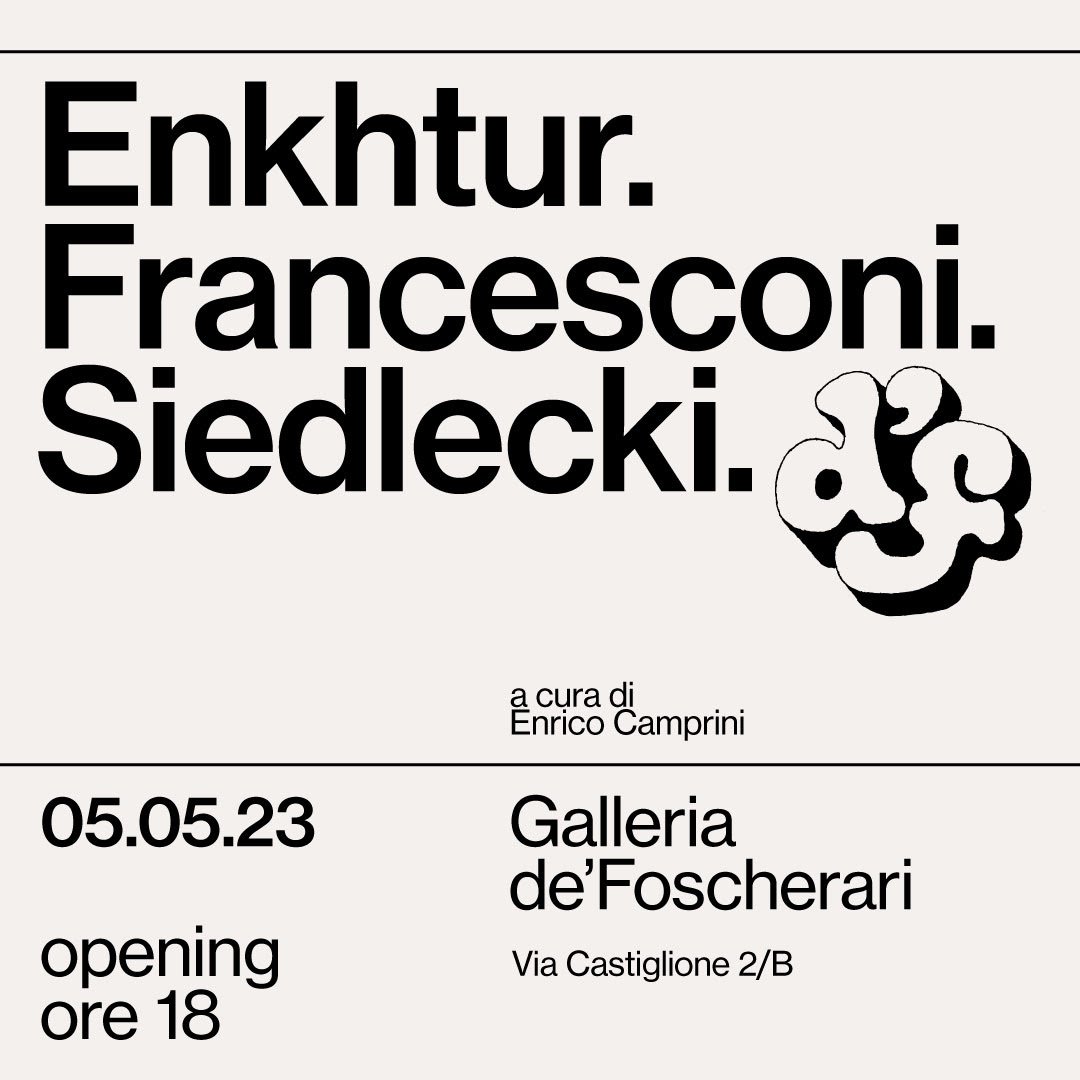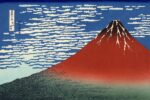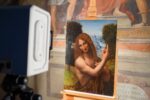Enkhtur | Francesconi | Siedlecki

Immaginata come una conversazione a tre voci, l’esposizione si propone di mettere in relazione, attraverso lavori degli ultimi anni e nuove produzioni, le ricerche di Bekhbaatar Enkhtur (Ulaanbaatar, Mongolia, 1994), Luca Francesconi (Mantova, 1979) e Namsal Siedlecki (Greenfield, USA, 1986).
Comunicato stampa
Galleria de’ Foscherari è lieta di presentare la mostra Enkthur – Francesconi – Siedlecki, curata da Enrico Camprini, che inaugurerà venerdì 5 maggio alle ore 18.
Immaginata come una conversazione a tre voci, l’esposizione si propone di mettere in relazione, attraverso lavori degli ultimi anni e nuove produzioni, le ricerche di Bekhbaatar Enkhtur (Ulaanbaatar, Mongolia, 1994), Luca Francesconi (Mantova, 1979) e Namsal Siedlecki (Greenfield, USA, 1986). La pratica dei tre artisti è caratterizzata dall’interesse specifico per il medium della scultura, indagato a partire da riferimenti eterogenei e con esiti differenti. Il dialogo tra le opere non si rivela tanto attraverso corrispondenze formali, quanto nella comune tendenza a concepire la scultura nei termini di una precisa idea di temporalità, declinata sia in chiave estetica che concettuale e simbolica. Idea di un tempo della scultura che a sua volta non può non evocare, in modo diretto o mediato, quello della vita e dei processi naturali e storico-culturali che essa sintetizza: in questo senso, le opere in mostra vanno intese come appunti per un discorso in progress sia sul mezzo scultoreo in sé, sia sul flusso di mutamenti che determina l’esistente.
I lavori di Enkhtur affrontano la questione dell’impermanenza e del cambiamento di stato dei materiali – spesso a partire da riferimenti iconografici e tradizioni della Mongolia, sua terra d’origine – mediante interventi realizzati direttamente nello spazio espositivo. Sculture in materiali organici e inorganici come cera d’api e argilla cruda, raramente sopravvivono alla mostra, mutando progressivamente e segnandone paradossalmente la durata. Similmente, le opere di Siedlecki indagano la natura trasformativa della materia da una prospettiva per certi versi alchemica, densa di riferimenti storico-culturali, dove tensioni opposte e processi in atto si concretizzano in sculture sempre in bilico tra inerzia e vita. Il tema della temporalità, da sempre centrale nella sua pratica, si colloca invece per Francesconi nell’interstizio che unisce analisi della forma scultorea e narrazione. Dedicando la propria indagine all’interazione uomo-natura, in particolare in relazione alle attuali modalità di produzione e all’agricoltura come misura del tempo, l’artista immagina la scultura come parte integrante di un vocabolario ecologico.
In occasione della mostra verrà pubblicato un catalogo, edito dalla galleria, con contributi del curatore Enrico Camprini e della poeta Federica Scaringello.
Galleria de' Foscherari is pleased to present the exhibition Enkthur - Francesconi - Siedlecki, curated by Enrico Camprini, which will open on Friday, May 5 at 6 p.m.
Envisioned as a three-voice conversation, the exhibition aims to relate, through works of recent years and new productions, the research of Bekhbaatar Enkhtur (Ulaanbaatar, Mongolia, 1994), Luca Francesconi (Mantua, 1979) and Namsal Siedlecki (Greenfield, USA, 1986). The practice of the three artists is characterized by a specific interest in the medium of sculpture, investigated from heterogeneous references and with different outcomes. The dialogue between the works is revealed not only through formal correspondences, but mostly in the common tendency to conceive sculpture in terms of a precise idea of temporality, conveyed in both aesthetic and conceptual perspectives. Idea of an inner time of sculpture which cannot fail to evoke, in a direct or mediated way, that of life and the natural and cultural-historical processes that it synthesizes: in this sense, the works in the exhibition should be understood as notes for a discourse in progress, both on the sculptural medium itself and on the flow of changes that constitutes the real.
Enkhtur's works address the issue of impermanence and the changing state of materials – often from iconographic references and traditions of Mongolia, his homeland – through interventions performed directly in the exhibition space. Sculptures made of organic and inorganic materials such as beeswax and raw clay rarely survive the exhibition, gradually mutating and paradoxically marking its duration. Similarly, Siedlecki's works investigate the transformative nature of matter from an alchemical perspective, dense with cultural-historical references, where opposing tensions and ongoing processes are embodied in sculptures always poised between inertia and life. Instead, Francesconi locates the theme of temporality, which has always been central to his practice, in an interstice between analysis of sculptural form and narrative. Devoting his investigation to human-nature interaction, particularly in relation to current modes of production and agriculture as a measure of time, the artist imagines sculpture as part of an ecological vocabulary.
A catalog with contributions by curator Enrico Camprini and poet Federica Scaringello will be published on the occasion of the exhibition.
Bekhbaatar Enkhtur (Ulaanbaatar, Mongolia, 1994) studied sculpture at the Academy of Fine Arts in Bologna and lives and works in Turin. He has been artist-in-residence at Kora Contemporary Arts Center, Castrignano De' greci; Mambo, Bologna; Manifattura Tabacchi, Florence; Fondazione Lanfranco Baldi, Pelago; and Dolomiti Contemporanee, Borca di Cadore. He has exhibited in galleries, nonprofit spaces and institutions. Recent exhibitions include solo shows: Imagining for Real, Matèria, Rome, 2023; Oasis, a project curated by Ramdom made in collaboration with Fondazione Elpis, 2022; Fuocherello, fonderia de Carli, Volvera TO; Cambio della guardia, Localedue, Bologna, 2021; Tsam, Marktstudio, Bologna, 2021; Zuult (A Breath of Art), Borgo Val Belluna, 2020. And group shows: An Ocean Standing, Lc Queisser Gallery, Tbilisi, GA; Il rituale del serpente, Ex Convento di San Francesco, Bagnacavallo, 2021; Room 114 XY, Car Drde, Bologna, 2019; La pratica quotidiana, Oratorio di San Sebastiano, Forlì 2019; Un anno lungo un giorno, Centro Pecci, Prato, 2019; Tragitti divaganti, P420, Bologna, 2018.
Luca Francesconi was born in Mantua in 1979. He lives and works in Mantua (IT).
He has participated in numerous exhibitions in public and private spaces such as: Fondazione Ratti - Como (2000), Biennale di Tirana - Tirana (2001), Fuori Uso - Pescara (2004), Galleria Civica di Trento - Trento (2004), Cristina Guerra Gallery - Lisbon (2006), Maison Populaire - Montreuil (2007), Palais de Tokyo - Paris (2009), Fondazione Sandretto Re Rebaudengo - Turin, Crac Alsace - Altkirch, Magasin - Grenoble, Fluxia - Milan (2010), Mot - Brussels, Chez Valentin - Paris (2011), Musées de Montbéliard - Montbéliard, Arte Nova-Art Basel - Miami (2012), Man - Nuoro, Museo Marino Marini- Florence (2013), Shanaynay - Paris (2014), Tonus - Paris, Museo Riso - Palermo, Kunsthalle Lissabon - Lisbon (2015), JupiterWoods - London, Tunnel Tunnel - Lausanne (2016), une, une with Miriam Cahn - Perpignan, Spazio Maria Calderara with Vettor Pisani - Milan (2017), 67 Steps - Los Angeles (2018), Palazzo delle Esposizioni - Rome (2019).
In 2009 he won the "Illy Present / Future" prize, awarded by a jury composed of Alexis Vaillant, Hans-Ulrich Obrist and Jens Hoffman, during Artissima in Turin, Italy, with Umberto Di Marino Gallery. In 2011, he was invited by Bice Curiger to "Illumination," 54th Venice Biennale. In 2014, Giovanni Carmine, director of the Kunsthalle St. Gallen, and Alexis Vaillant, chief curator of CAPC-Bordeaux, invited him to the "THENnow" section of the MiArt fair, with a work made in collaboration with Jimmie Durham. In 2016 he participates in the XXV edition of the National Visual Arts Award City of Gallarate, MAGA Museum. In 2020 he takes part in the group exhibition AGAINandAGAINand, curated by Lorenzo Balbi at MAMbo, Bologna. In 2022 he makes his first solo exhibition at Galeria Pedro Cera - Lisbon and Gatto Magico at Museo Burel - Belluno. In 2023 he takes part in the ArtCity Bologna program with the work Untitled. Eel Fat exhibited at Palazzo Malvezzi, Bologna in collaboration with the Museo della Civiltà Contadina di San Marino di Bentivoglio.
Between 2008 and 2010 he co-directed the independent Brown project space in Milan.
He has been actively collaborating with Galleria Umberto Di Marino since 2006, with whom he has held four solo exhibitions:
A naked tree and some other works (2006), Calendario delle Semine (2009) and pane pane vino canale di scolo, curated by Jason Hwang (2014), Hormone Disruptors (2021).
Namsal Siedlecki (Greenfield, USA 1986), lives and works in Seggiano, Italy. In 2015 he won the Cy Twombly Italian Affiliated Fellow in Visual Arts at the American Academy in Rome.
His works were recently exhibited in venues such as: MAXXI Museum, Rome; Musee Bargin, Clermont Ferrand, France; Villa Medici - Academie de France, Rome, Premio Cairo, Palazzo Reale, Milan, Galleria Acappella, Napoli; Very Project Space, Berlin; ChertLüdde, Berlin; 6th Moscow International Biennale for Young Art, Moscow; Frankfurt am Main, Berlin; Galeria Boavista, Lisbon; Centro per l’Arte Contemporanea Luigi Pecci, Prato; Galeria Madragoa, Lisbon; Villa Romana, Florence; Fondazione Sandretto Re Rebaudengo, Turin; American Academy in Rome, Rome; Fondazione Bevilacqua la Masa, Venice; Cripta747, Turin.



